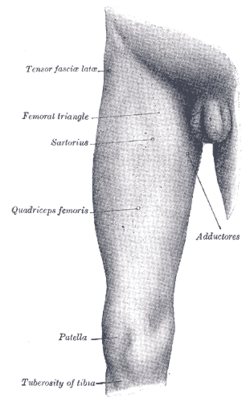Thigh
| Thigh |
 |
| Front and medial aspect of male right thigh |
| Latin |
femur |
In humans the thigh is the area between the pelvis and the knee. Anatomically, it is part of the lower limb.[1]
The single bone in the thigh is called the femur. This bone is very thick and strong (due to the high proportion of cortical bone), and forms a ball and socket joint at the hip, and a condylar joint at the knee.
Fascial compartments
In cross-section, the thigh is divided up into three fascial compartments. These compartments use the femur as an axis, and are separated by tough connective tissue membranes (or septa). Each of these compartments has its own blood and nerve supply, and contains a different group of muscles.
- Medial fascial compartment of thigh, adductor
- Posterior fascial compartment of thigh, flexor, hamstring
- Anterior fascial compartment of thigh, extensor
Blood vessels
The arterial supply is by the femoral artery and the obturator artery. The lymphatic drainage closely follows the arterial supply and drains to the lumbar lymphatic trunks on the corresponding side, which in turn drains to the cisterna chyli.
The deep venous system of the thigh consists of the femoral vein, the proximal part of the popliteal vein, and various smaller vessels; these are the site of proximal deep venous thrombosis. The venae perfortantes connect the deep and the superficial system, which consists of the saphenous veins (the site of varicose veins).
Thigh weakness
Thigh weakness can result in a positive Gowers' sign on physical examination.
Muscles and Fascia of the Thigh
Front of thigh muscles from Gray's Anatomy of the human body from 1918.
|
Back thigh muscles of the gluteal and posterior femoral regions from Gray's Anatomy of the human body from 1918.
|
Cross-section through the middle of the thigh.
|
|
References
- ↑ thigh at Dorland's Medical Dictionary
|
List of muscles of lower limbs (TA A04.7, GA 4.465) |
|
ILIAC Region
/ ILIOPSOAS |
psoas major/psoas minor · iliacus
|
|
| BUTTOCKS |
gluteals: (maximus, medius, minimus) · tensor fasciae latae
lateral rotator group: quadratus femoris · inferior gemellus · obturator internus · superior gemellus · piriformis
|
|
THIGH /
compartments |
|
Anterior
|
sartorius · quadriceps (rectus femoris, vastus lateralis, vastus intermedius, vastus medialis) · articularis genu
|
|
|
Posterior/hamstring
|
biceps femoris · semitendinosus · semimembranosus
|
|
|
Medial
|
pectineus · obturator externus · gracilis · adductor (longus, brevis, magnus, minimus)
|
|
|
Fascia
|
Femoral sheath (Femoral canal) · Femoral ring
Adductor canal · Adductor hiatus
fascia lata (Iliotibial tract, Lateral intermuscular septum of thigh, Medial intermuscular septum of thigh, Fascia cribrosa/Saphenous opening) · Muscular lacuna
|
|
|
LEG/
Crus/
compartments |
|
Anterior
|
tibialis anterior · extensor hallucis longus · extensor digitorum longus · peroneus tertius
|
|
|
Posterior
|
superficial · triceps surae (gastrocnemius, soleus, accessory soleus, Achilles tendon) · plantaris
deep · tarsal tunnel (flexor hallucis longus, flexor digitorum longus, tibialis posterior) · popliteus
|
|
|
Lateral
|
peroneus muscles (longus, brevis)
|
|
|
Fascia
|
Pes anserinus
crural fascia (Anterior crural intermuscular septum, Posterior crural intermuscular septum, Transverse intermuscular septum)
|
|
|
| FOOT |
|
Dorsal
|
extensor hallucis brevis · extensor digitorum brevis
|
|
|
Plantar
|
1st layer (abductor hallucis, flexor digitorum brevis, abductor digiti minimi) · 2nd layer (quadratus plantae, lumbrical muscle) · 3rd layer (flexor hallucis brevis, adductor hallucis, flexor digiti minimi brevis) · 4th layer (dorsal interossei, plantar interossei)
|
|
|
Fascia
|
Plantar fascia
retinacula (Peroneal, Inferior extensor, Superior extensor, Flexor)
|
|
|
|
|
anat (h/n, u, t/d, a/p, l)/phys/hist
|
noco(m, s, c)/cong(d)/tumr, sysi/, injr
|
|
|
|
|


